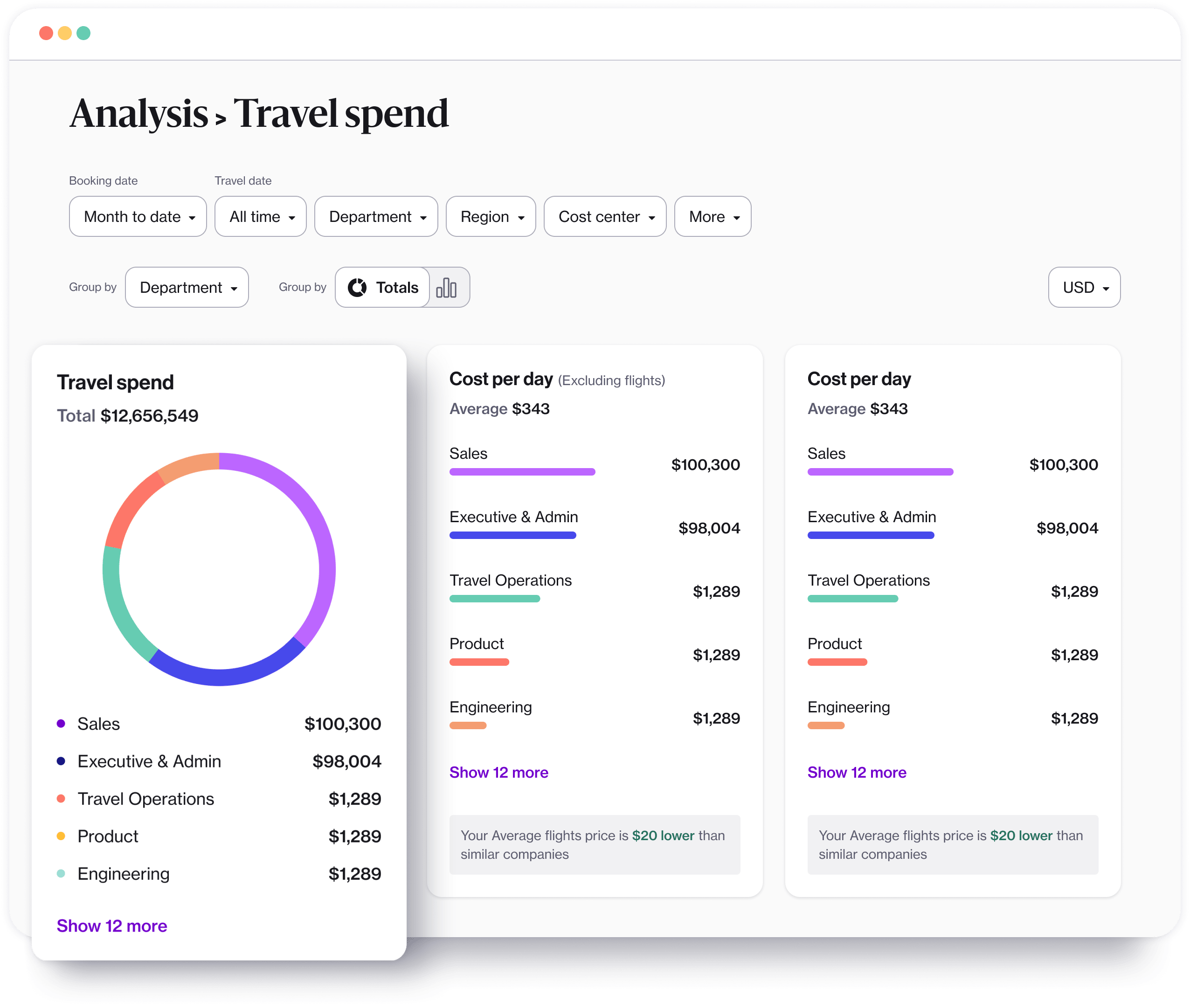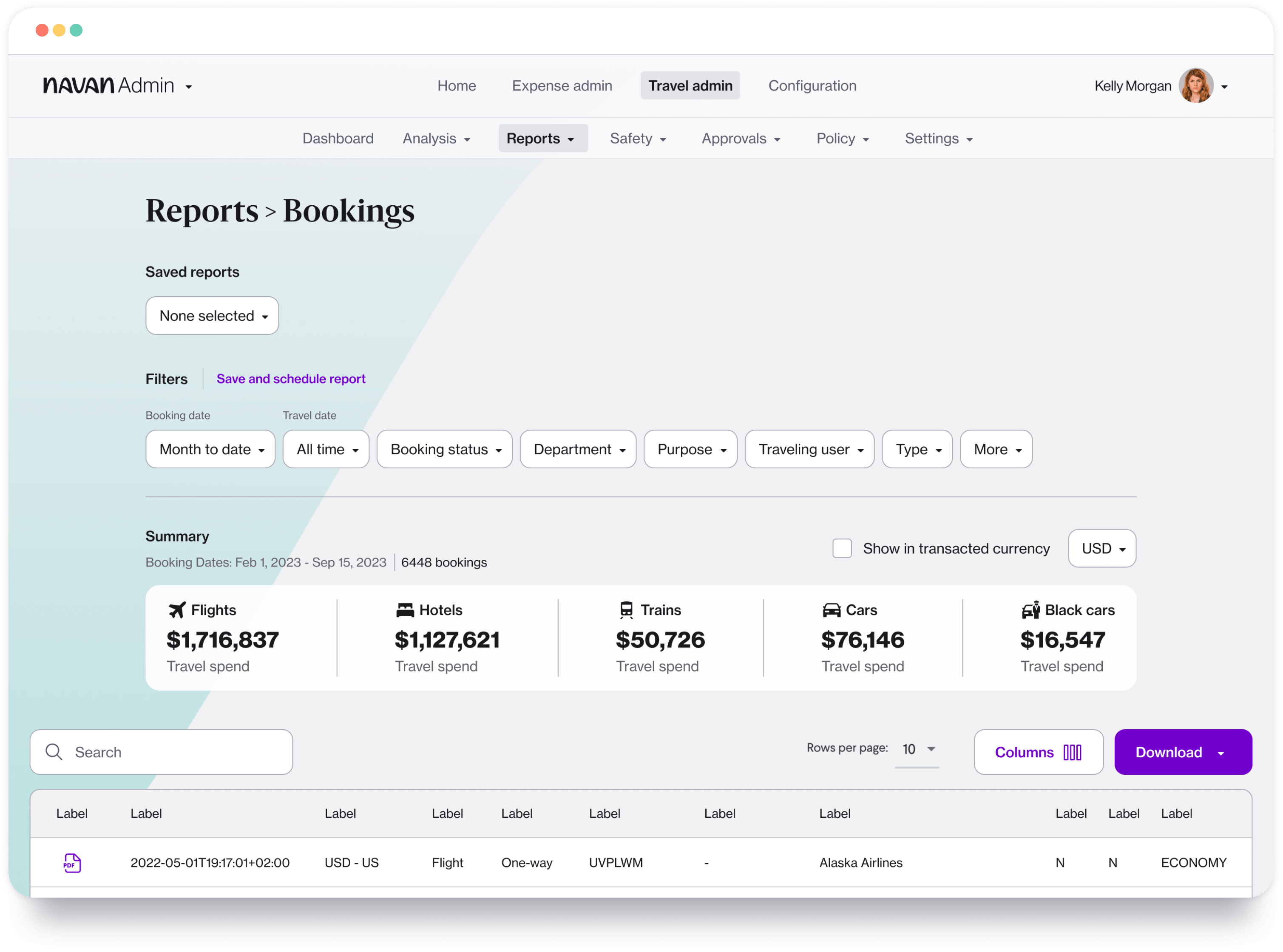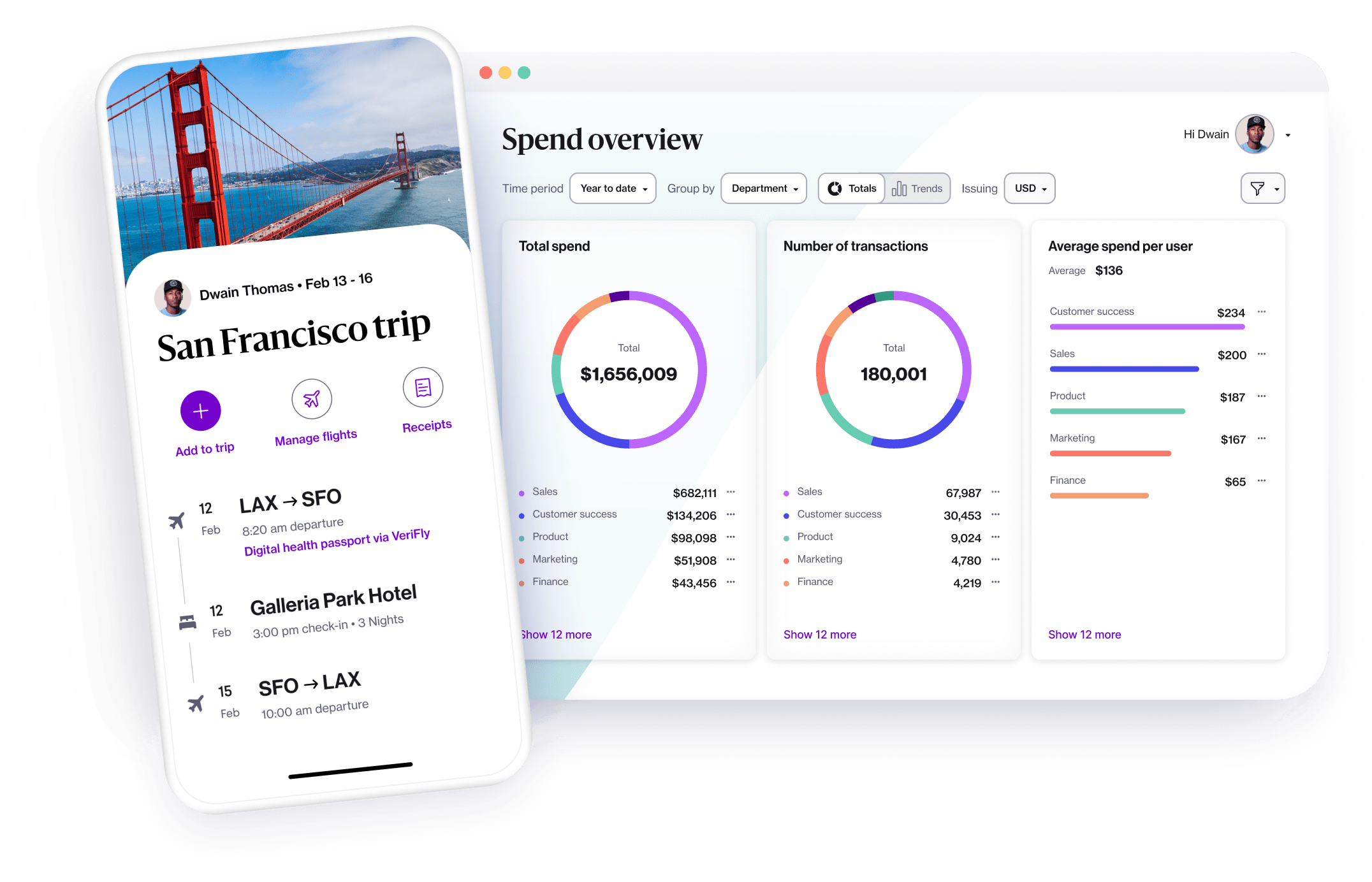Here’s How to Unlock the Power of Business Travel Analytics

Unclear patterns and unmonitored expenses are untapped opportunities for cost savings.
Without access to robust business travel analytics, companies are running their travel programs blindfolded.
But by harnessing the power of data-driven insights, companies can optimize costs, ensure policy compliance, and enhance the overall experience for employees. Here’s how.

Above: A desktop view of travel spend analysis using the Navan app.
The Crucial Role of Business Travel Analytics
Savvy finance leaders and travel managers use advanced analytics to make data-driven decisions that optimize their company’s business travel programs. Here are five reasons why gaining a better understanding of travel insights could be a game-changer for your business.
1. Cost Optimization
Understanding where, when, why, and how employees travel allows finance teams to identify cost-saving opportunities. By analyzing patterns and expenses, businesses can negotiate better deals with vendors, optimize travel budgets, and eliminate unnecessary spending.
2. Policy Compliance
Travel policies are essential for controlling costs and ensuring employee safety and satisfaction. Advanced travel analytics provide valuable insights into policy compliance and highlight areas where policies may need adjustment or reinforcement. With real-time data, managers can address compliance issues promptly, reducing the risk of policy violations and associated costs.
Addressing Policy Compliance Challenges
According to the latest research from Skift, a growing number of managers say they have less than 75% travel policy compliance among employees.
Lower compliance can lead to higher costs and require additional work from employees to investigate and correct the issues. Turning compliance rates around begins with policy. Get T&E policy back on track with our guide, 6 Key Strategies for Optimizing T&E Policy.
3. Risk Management
Business travel comes with inherent risks, from travel disruptions to safety concerns. Analytics enable proactive risk management by identifying potential risks and trends before they escalate. By monitoring travel patterns and external factors like weather and geopolitical events, businesses can mitigate risks and ensure the safety and well-being of their employees.
4. Strategic Decision-Making
By analyzing employee travel trends alongside other business metrics, such as sales performance or market trends, companies can identify correlations and opportunities for growth. Whether they’re expanding into new markets or reallocating resources, analytics provide the intelligence to drive strategic initiatives.
5. Employee Experience
A positive travel experience is crucial for employee satisfaction and productivity. By analyzing travel data, businesses can identify pain points and opportunities to enhance the employee experience. Whether the goal is streamlining the booking process, offering personalized options, or providing support during disruptions, analytics enable businesses to tailor their travel programs to meet the needs and preferences of their employees.

Above: A desktop view of a travel booking report in the admin interface of the Navan app.
Key Travel Data Analytics to Track
To gauge the success of your travel program, diligently tracking several key metrics is crucial to ensure efficiency, compliance, and cost-effectiveness.
Travel Expense Analytics
- Total travel spend: Get an overview of total spend and spend by booking type in order to identify cost-saving opportunities and budget for future travel expenses.
- Average trip cost: Calculate the average cost per trip to benchmark against industry standards and identify outliers for further analysis.
- Hotel attachment rate: Hotel attachment is when a trip has flight and hotel bookings. Knowing your company’s hotel attachment rate can provide valuable insights into your travel program and help identify opportunities for increased savings.
Travel Policy Compliance
- Out-of-policy bookings: Measure the percentage of trips that do not adhere to the company’s policies to ensure compliance and identify areas for improvement.
- Booking lead time: Track the time between booking and departure to optimize itinerary planning and identify opportunities for cost savings.
- Adoption: Determine the overall adoption rate of the systems and technology in place and develop a plan to increase it.
Traveler Safety, Well-Being, and Satisfaction Metrics
- Safety incidents: Monitor incidents such as flight delays, cancellations, or safety concerns to assess risk and ensure employee well-being.
- Satisfaction scores: Gather feedback from travelers to measure satisfaction levels and identify areas for improvement.
- Well-being indicators: Tracking nights and weekend nights away, flight duration, red-eye bookings, number of connections, and layover length can help administrators make critical decisions about policies, staffing, and paid time off.
The Big Picture
- Carbon emissions: Measure the environmental impact of business travel by tracking carbon emissions and identify opportunities for sustainability initiatives.
- Top spenders and savers: Understand your top savers and spenders by individual and department. These booking trends help you determine which aspects of the company policy are working and which can be adjusted.
- Return on investment (ROI): Assess the value of the travel program and compare that figure to business outcomes such as sales revenue or new client acquisition.
Meet Ava, the AI-Powered Data Analyst
Want to know how to save on your travel program, but don’t know where to start? Just ask Ava, Navan’s virtual assistant. The AI-powered data analyst uses machine learning and predictive analytics to analyze your company’s travel spend to provide tailored advice.
Common Travel Analytics Challenges
Tracking business travel analytics can be a complex endeavor, and companies often face several challenges in the process. Here are some common hurdles:
- Data fragmentation: Business travel data is often scattered across various systems and platforms, including booking tools, expense management systems, and corporate credit card accounts.
- Data quality issues: Inaccurate or incomplete data can hinder the effectiveness of data analyses. Without reliable data, companies may make flawed decisions based on inaccurate insights.
- Lack of integration: Integrating travel data with other business tools, such as expense management systems or Enterprise Resource Planning (ERP) systems, is crucial for obtaining a holistic view of travel-related activities and their impact on the organization.
- Resistance to change: Finance teams may face resistance from employees or stakeholders who are accustomed to traditional processes or skeptical about the value of analytics.
- Cost considerations: Investing in technology infrastructure, data integration, and analytics tools can be costly for companies. Consider the cost of implementation and the price of ongoing maintenance.

Above: A collage view of a trip itinerary on the Navan mobile app and the Navan spend overview on the desktop app.
Gain Visibility and Control with Navan
What if your company could combine the power of a travel agency, expense management software, and an analytics center?
Navan is a travel and expense (T&E) management software solution that does just that.
- Administrators build in T&E policies to control spend
- Employees self-book trips and expense within these parameters
- Real-time dashboards give immediate visibility into every dollar spent
From booking to bookkeeping, Navan gives your company one place to monitor T&E. Rest easy knowing out-of-policy spend is being prevented before it happens, and slice and dice data to find ways to optimize your travel program based on real-time, contextual insights.
This content is for informational purposes only. It doesn't necessarily reflect the views of Navan and should not be construed as legal, tax, benefits, financial, accounting, or other advice. If you need specific advice for your business, please consult with an expert, as rules and regulations change regularly.
More content you might like
Take Travel and Expense Further with Navan
Move faster, stay compliant, and save smarter.
